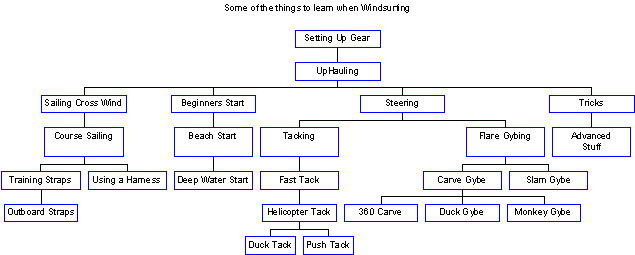 | Safety on the water:
You might not know it but it's pretty easy to drown even in 5cm of water!
Use your common sense:
 | Know the place where you surf: know about currents, fishing nets,
winds,... |
 | Know if there are other surprises ...like big fish with sharp teeth
|
 | Wear a life jacket!!! |
 | Check your equipment each time you go to surf for wear and tear
|
 | Check the local weather report prior to surfing. |
 | Don't windsurf on a full stomach. |
 | Don't even get in the water if you feel the conditions are beyond your
capabilities. |
 | Don't surf alone! |
|
 | Getting your equipment to the water:
|
 | Standing up on the board:
 | position the board so it is perpendicular to the wind direction
|
 | position the sail so it is perpendicular to the board and the mast lying
in the wind direction |
 | go to the opposite side of the board that the sail is on (your back to
the wind) |
 | get hold of the up-haul rope, when you are trying to get hold of the
up-haul line don't put any hand between the mast and the board - it can be
very painful! |
 | get on the board (like seals get onto land) and then assume a squat
position on the board, with your legs shoulder width apart, and the mast
base between them |
|
 | Lifting the sail from the water:
 | raise your body slowly using the up-haul rope and your free hand for
balance |
 | keep knees slightly bent and lean backwards
|
 | use the knots in the up-haul rope and your weight to raise the sail
more easily |
 | use a horizontal slicing and lifting action, at first, to let water run
off the sail and reduce it's apparent weight |
 | apply pressure on your left and right feet to keep your back to the wind
direction, the sail in the wind direction and the board perpendicular to the
wind direction |
 | when the tip of the boom is just touching the water take a breather and
hold that position |
 | continue pulling the sail upwards and your body until the mast and boom
front are about 30 cm from the middle of your chest, try and hold this
position for a few seconds |
|
 | Setting off:
 | when you have lifted the sail out of the water and have still maintained
your back to the wind, sail in the wind direction... |
 | your free hand (which should always be the one nearest the front of the
board) should cross over the hand that is holding the up-haul line and grab
hold of the boom about 20cm from the front
 | the last knot (nearest the boom) in the up-haul rope should be held by
the hand nearest the back of the board |
|
 | then release the up-haul rope and grab hold of the boom about shoulder
width apart from the hand that is already on the boom. |
 | slowly pull the rear of the boom so the rear of the sail comes towards
the board |
 | if you feel the power of the sail is too strong push out the rear of the
boom or let go of the boom with your trailing hand and start the process
again |
|
 | Turning Left & Right:
 | If you keep the sail in a parallel direction to board motion and pivot
the sail backwards you will turn left slowly |
 | If you keep the sail in a parallel direction to board motion and pivot
the sail forwards you will turn right slowly |
|
 | Turning Back:
 | Pull the sail up so the clue end is just above water level
|
 | holding the mast near the boom turn the board round by taking small
steps with your feet round the board until you are facing the way you came
|
|
 | Emergency - Actions & Signals:
 | RULE 1 - DON'T PANIC! (even if its a big mouth with sharp teeth
mistaking you for lunch)
 | A recent event that I witnessed: |
 | A beginner drops the sail in the water and sits on the
board...suddenly they hear the siren of a big boat |
|
 | If you are injured your buddies will have seen you go down AND your life
jacket will keep you from going further down |
 | If you are not injured and:
 | you have a broken mast, or sail, or boom: ditch what you can't use
fold or dismantle the rest and either sit or lie on it and use the board
as a canoe to paddle home |
|
 | Know your basic emergency signals of seamanship:
 | Clenched fist waving side to side over your head = HELP! |
|
|
